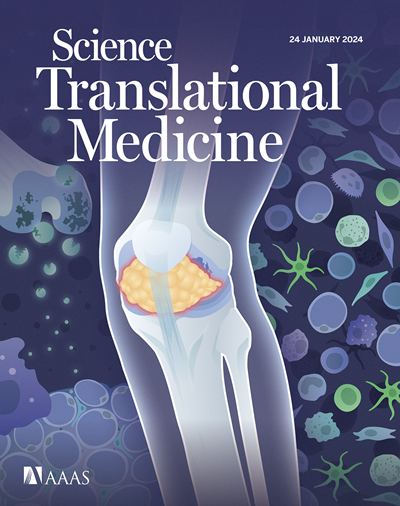Vaccination with an mRNA-encoded membrane-bound HIV envelope trimer induces neutralizing antibodies in animal models
IF 14.6
1区 医学
Q1 CELL BIOLOGY
引用次数: 0
Abstract
A protective vaccine against human immunodeficiency virus (HIV) will likely need to induce broadly neutralizing antibodies (bnAbs) that engage relatively conserved epitopes on the HIV envelope glycoprotein (Env) trimer. Nearly all vaccine strategies to induce bnAbs require the use of complex immunization regimens involving a series of different immunogens, most of which are Env trimers. Producing protein-based clinical material to evaluate such relatively complex regimens in humans presents major challenges in cost and time. Furthermore, immunization with HIV trimers as soluble proteins induces strong nonneutralizing responses to the trimer base, which is normally occluded on the virion. These base responses could potentially detract from the elicitation of nAbs and the eventual induction of bnAbs. mRNA vaccine platforms offer potential advantages over protein delivery for HIV vaccine development, including increased production speed, reduced cost, and the ability to deliver membrane-bound trimers that might facilitate improved immuno-focusing to nonbase epitopes. We report the design of mRNA-delivered soluble and membrane-bound forms of a stabilized native-like Env trimer (BG505 MD39.3); initial immunogenicity evaluation in rabbits that triggered clinical evaluation; and more comprehensive evaluation of B cell, T cell, and antibody responses in nonhuman primates. mRNA-encoded membrane-bound Env immunization elicited reduced off-target base-directed Env responses and stronger nAb responses compared with mRNA-encoded soluble Env. Overall, mRNA delivery of membrane-bound Env appears promising for enhancing B cell responses to subdominant epitopes and facilitating rapid translation to clinical testing, which should assist HIV vaccine development.

用mrna编码的膜结合HIV包膜三聚体接种疫苗可在动物模型中诱导中和抗体
针对人类免疫缺陷病毒(HIV)的保护性疫苗可能需要诱导广泛中和抗体(bnAbs),这些抗体参与HIV包膜糖蛋白(Env)三聚体上相对保守的表位。几乎所有诱导bnAbs的疫苗策略都需要使用复杂的免疫方案,涉及一系列不同的免疫原,其中大多数是Env三聚体。生产基于蛋白质的临床材料来评估这种相对复杂的人体方案在成本和时间上面临重大挑战。此外,用HIV三聚体作为可溶性蛋白免疫可诱导对通常封闭在病毒粒子上的三聚体碱基产生强烈的非中和性反应。这些碱基反应可能潜在地影响nab的激发和最终的诱导。mRNA疫苗平台为HIV疫苗开发提供了相对于蛋白质递送的潜在优势,包括提高生产速度、降低成本,以及递送膜结合三聚体的能力,这可能有助于改善对非碱基表位的免疫聚焦。我们报道了mrna递送的可溶性和膜结合形式的稳定的原生样Env三聚体(BG505 MD39.3)的设计;兔初步免疫原性评价引发临床评价;以及对非人灵长类动物的B细胞、T细胞和抗体反应进行更全面的评估。与mrna编码的可溶性Env相比,mrna编码的膜结合Env免疫引起的脱靶碱基导向Env应答减少,nAb应答更强。总的来说,膜结合Env的mRNA传递似乎有希望增强B细胞对亚优势表位的反应,并促进快速翻译到临床测试,这应该有助于HIV疫苗的开发。
本文章由计算机程序翻译,如有差异,请以英文原文为准。
求助全文
约1分钟内获得全文
求助全文
来源期刊

Science Translational Medicine
CELL BIOLOGY-MEDICINE, RESEARCH & EXPERIMENTAL
CiteScore
26.70
自引率
1.20%
发文量
309
审稿时长
1.7 months
期刊介绍:
Science Translational Medicine is an online journal that focuses on publishing research at the intersection of science, engineering, and medicine. The goal of the journal is to promote human health by providing a platform for researchers from various disciplines to communicate their latest advancements in biomedical, translational, and clinical research.
The journal aims to address the slow translation of scientific knowledge into effective treatments and health measures. It publishes articles that fill the knowledge gaps between preclinical research and medical applications, with a focus on accelerating the translation of knowledge into new ways of preventing, diagnosing, and treating human diseases.
The scope of Science Translational Medicine includes various areas such as cardiovascular disease, immunology/vaccines, metabolism/diabetes/obesity, neuroscience/neurology/psychiatry, cancer, infectious diseases, policy, behavior, bioengineering, chemical genomics/drug discovery, imaging, applied physical sciences, medical nanotechnology, drug delivery, biomarkers, gene therapy/regenerative medicine, toxicology and pharmacokinetics, data mining, cell culture, animal and human studies, medical informatics, and other interdisciplinary approaches to medicine.
The target audience of the journal includes researchers and management in academia, government, and the biotechnology and pharmaceutical industries. It is also relevant to physician scientists, regulators, policy makers, investors, business developers, and funding agencies.
 求助内容:
求助内容: 应助结果提醒方式:
应助结果提醒方式:


